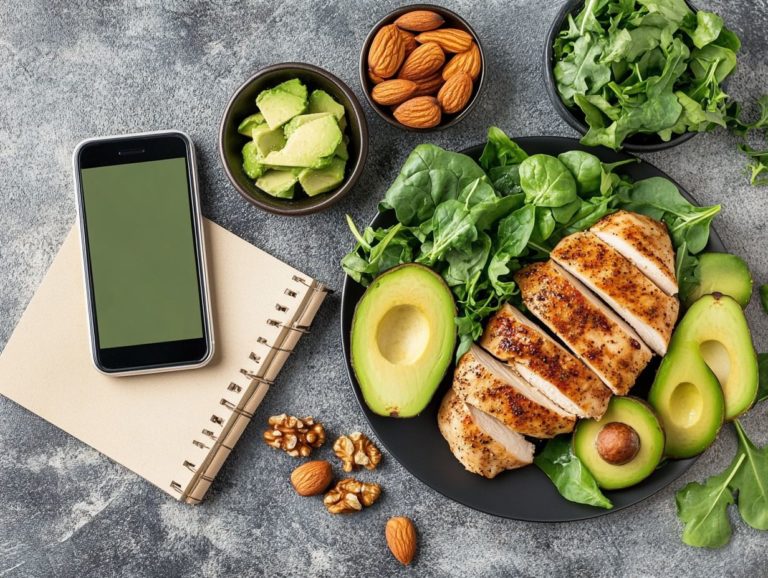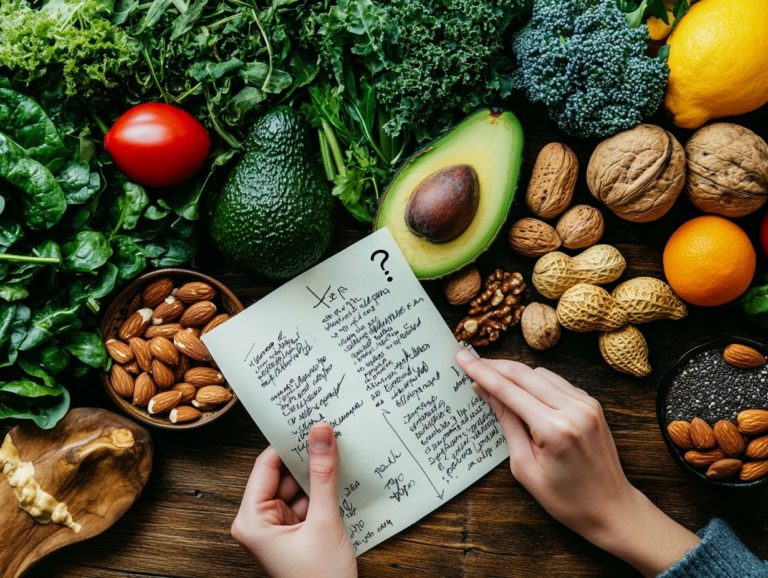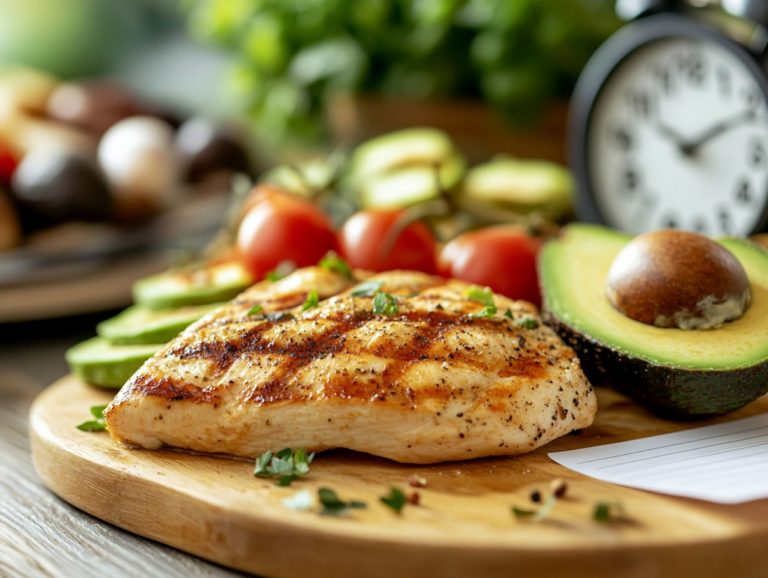How to Shop for Keto: Common FAQs
The Keto diet has skyrocketed in popularity, captivating many with its promise of weight loss and enhanced health through a low-carb, high-fat eating plan. But what does this diet truly entail for you? By understanding your carb intake and net carbs, you can better navigate this dietary approach.
This article delves into the fundamental principles of the Keto diet, highlighting the delectable keto-friendly foods you can indulge in, the healthy fat sources to embrace, and the proteins you should prioritize.
You’ll also discover what to steer clear of and gain essential shopping tips to streamline your Keto journey. You will find answers to common questions about dining out, managing cravings, and staying on track while traveling. Plus, learn how to tackle keto flu like a pro and how to use ketone strips to monitor ketosis.
Immerse yourself in this guide to discover how to tailor the Keto diet to fit your lifestyle seamlessly!
Contents
- Key Takeaways:
- What is the Keto Diet?
- What Foods Can You Eat on the Keto Diet?
- What are the Best Sources of Low-Carb Vegetables for the Keto Diet?
- What Foods Should You Avoid on the Keto Diet?
- What are the Worst Sources of Carbohydrates for the Keto Diet?
- How to Shop for Keto-Friendly Foods?
- What are the Best Places to Shop for Keto-Friendly Foods?
- What are Some Tips for Reading Nutrition Labels on Keto-Friendly Foods?
- What are Some Common FAQs About Shopping for Keto?
- Can You Eat Out on the Keto Diet?
- Can You Have Cheat Days on the Keto Diet?
- How to Handle Social Events and Gatherings on the Keto Diet?
- Frequently Asked Questions
- What is the keto diet and how does it affect my shopping habits?
- What foods should I avoid when shopping for keto?
- What are some keto-friendly foods I should include in my shopping list?
- Can I still enjoy sweet treats while on the keto diet?
- Do I need to shop at specialty stores for keto-friendly foods?
- How can I save money while shopping for keto?
Key Takeaways:
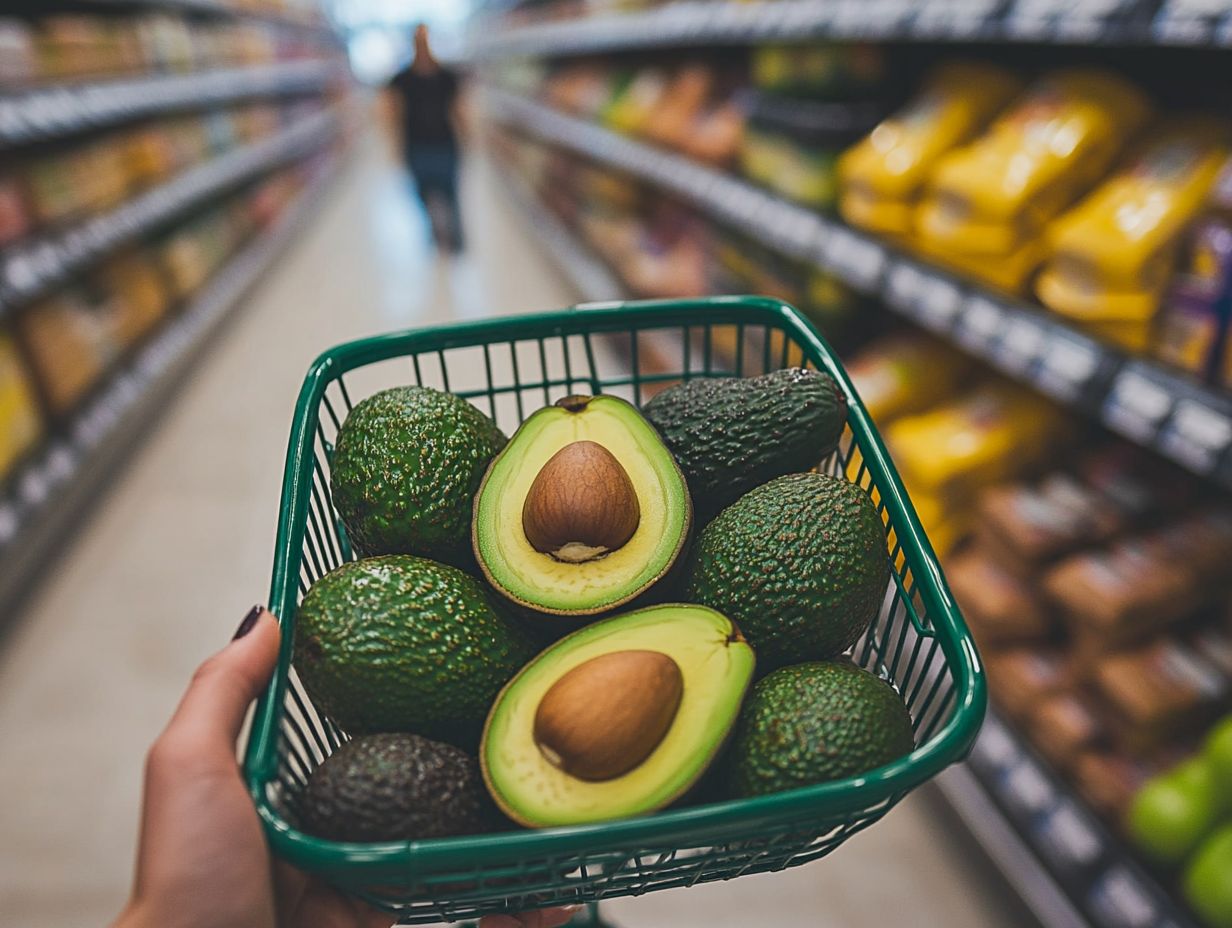
- Look for healthy sources of fats, protein, and low-carb vegetables when shopping for the Keto Diet. Checking your keto shopping list can help!
- Avoid high-carb and unhealthy sources of carbohydrates, fats, and protein.
- Plan ahead and read nutrition labels when shopping for keto-friendly foods. Be prepared for social events and traveling on the Keto Diet. Don’t forget to track your macros and calorie intake!
What is the Keto Diet?
The Keto Diet is a sophisticated low-carb, high-fat eating plan designed to usher your body into a metabolic state known as ketosis. In this state, your body becomes remarkably adept at burning fat for fuel, shifting away from carbohydrates. By staying in ketosis, you can maximize the keto benefits such as weight loss and improved mental clarity.
Reduce carbs while focusing on healthy fats and enough protein. This combination paves the way for effective weight loss and enhanced overall health. By carefully monitoring your calorie intake and macronutrient ratios, you can experience a host of keto benefits, including heightened energy levels and improved mental clarity.
This makes the Keto Diet an increasingly popular choice for those like you who are in pursuit of effective dietary solutions, including keto recipes that fit seamlessly into your lifestyle.
What Foods Can You Eat on the Keto Diet?
On the Keto Diet, you have the opportunity to savor a diverse array of keto-friendly foods that are low in carbohydrates and abundant in healthy fats, enabling you to maintain ketosis while delighting your palate. Crafting a keto meal plan with these foods can greatly enhance your diet.
The diet focuses on high-fat sources such as olive oil, nuts, seeds, and avocados, alongside premium proteins like grass-fed beef and organic chicken. Additionally, incorporating keto-friendly vegetables and fruits like raspberries can bring variety to your meals.
By also incorporating specific low-carb vegetables and nutrient-dense foods, you can elevate your meals with essential vitamins and minerals. This makes it effortless to craft delicious keto recipes that perfectly align with your dietary aspirations, such as a tasty keto breakfast with eggs and veggies.
What are the Best Sources of Healthy Fats for the Keto Diet?
The best sources of healthy fats for your Keto Diet include nutrient-dense options like olive oil, avocado, nuts, and seeds. These aren t just tasty additions; they provide essential fatty acids that support your overall health and help you maintain ketosis. Healthy fats are critical to your keto journey, contributing to the higher calorie intake required for this low-carb lifestyle. By incorporating these fats into your meals, you’ll not only experience improved satiety and increased energy levels but also enjoy enhanced flavors, making them an essential part of your ketogenic meal plan. Including bone broth in your diet can also help replenish electrolytes.
Incorporating healthy fats into your daily meals can be both straightforward and delightful. For example, drizzling olive oil over a crisp salad or using it as the foundation for homemade dressings adds richness and a wealth of antioxidants. Avocados can be relished sliced on their own, blended into smoothies, or spread on low-carb bread, offering you fiber and a variety of vitamins. Using almond flour for baking can also add a nutritious touch to your dishes.
Nuts and seeds are perfect as snacks or as toppings for yogurt, delivering not just healthy fats but also protein and essential minerals that bolster your body’s functions. By embracing these options, you can ensure that your diet remains deliciously varied while you stay true to the principles of keto. Try Greek yogurt with a sprinkle of nuts and seeds for a refreshing snack.
What are the Best Sources of Protein for the Keto Diet?
The finest sources of protein for your Keto Diet include options such as grass-fed beef, organic chicken, eggs, and fatty fish. These choices not only help you maintain muscle mass while adhering to low-carb guidelines but also provide the essential amino acids necessary for supporting your bodily functions and recovery.
Including these high-quality protein sources in your meals will aid you in achieving your macro goals and keep you feeling satisfied and nourished throughout the day.
Protein plays a pivotal role in metabolic processes, helping to enhance your satiety and curb cravings that could potentially derail your weight-loss journey. For example, incorporating eggs into your breakfast can serve as a versatile base, whether you prefer them scrambled, poached, or transformed into a delightful omelet packed with low-carb vegetables like spinach and bell peppers.
Grilling or roasting chicken not only brings out its rich flavor but also ensures it remains moist and enjoyable, especially when paired with a side of cauliflower rice. Opting for sustainable sources like wild-caught salmon boosts your intake of omega-3 fatty acids and elevates the overall health benefits of your diet. Supplementing with bone broth can also help to replenish electrolytes.
By creatively preparing these protein options, you can savor a diverse and flavorful dining experience while staying true to your ketogenic lifestyle. Always remember to keep your keto meal plan varied and exciting to ensure long-term adherence.
What are the Best Sources of Low-Carb Vegetables for the Keto Diet?
Low-carb vegetables like leafy greens, broccoli, and cauliflower are exceptional choices for the Keto Diet. They offer essential nutrients and fiber while keeping your carbohydrate intake pleasantly low. These keto-friendly vegetables are a staple in any ketogenic diet.
Not only do these vegetables elevate the variety in your meals, but they also contribute to your overall health by providing vital vitamins and minerals necessary for your body s functions. By incorporating these keto-friendly vegetables into your diet, you can savor a delightful range of flavors and textures. This makes your ketogenic meal plan both satisfying and nutritious.
These low-carb vegetables are incredibly versatile. You can enjoy them raw in salads, steamed, roasted, or even blended into smoothies. Some of the finest options to include are:
- zucchini
- bell peppers
- asparagus
- spinach
All of which add vibrant colors and a wealth of antioxidants to your plate. These veggies pair beautifully with various protein sources and help keep you feeling full thanks to their high water content.
Mix these vegetables into your recipes for a tasty twist on your meals! Think stir-fries, casseroles, or omelets. Including keto-friendly fruits like raspberries can also add a sweet touch to your dishes.
What Foods Should You Avoid on the Keto Diet?
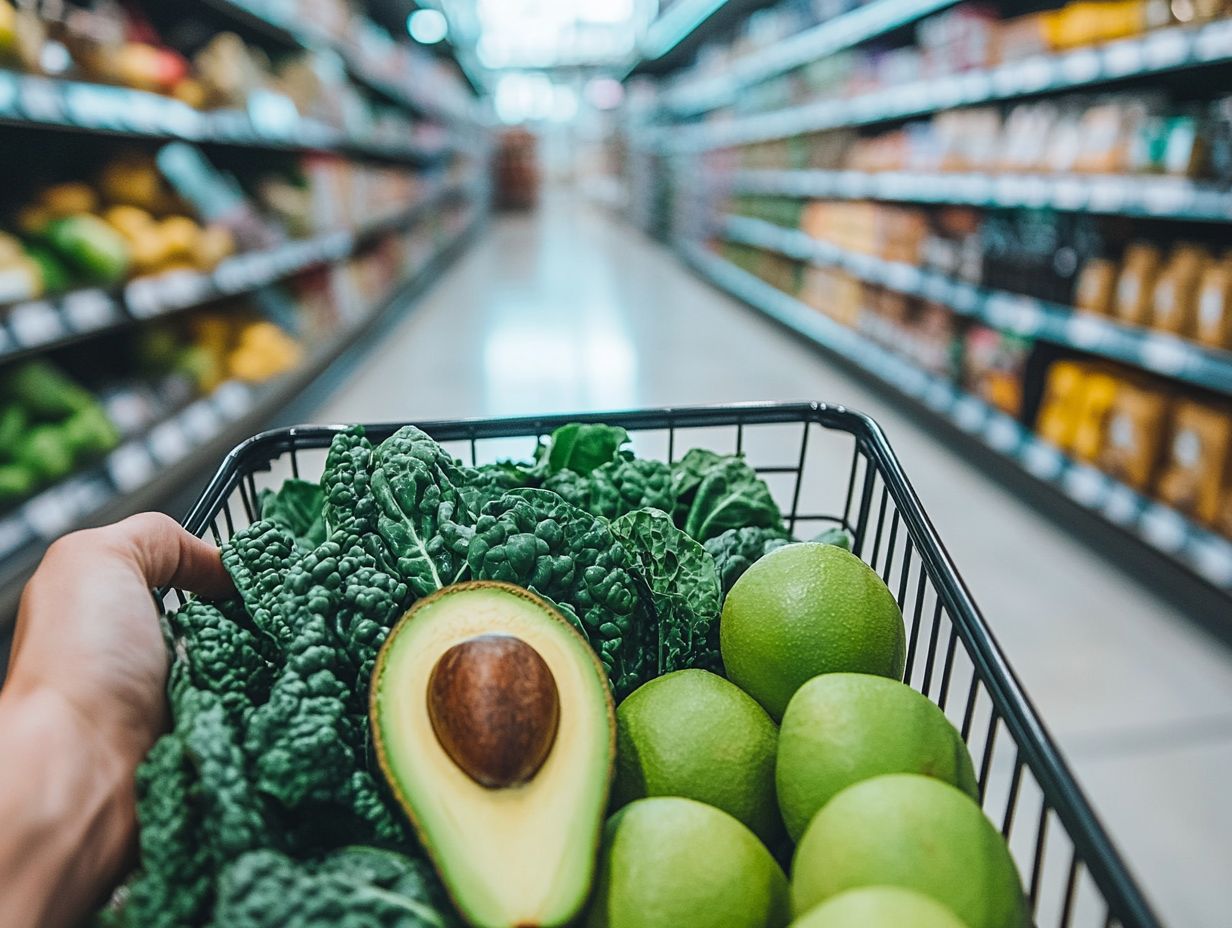
On the Keto Diet, it s important to steer clear of foods high in carbohydrates, as these can impede your journey to achieve and maintain ketosis, ultimately impacting your weight loss success. This means saying goodbye to sugary snacks, grains, starches, and processed foods that often come with sneaky hidden carbs. Keeping a keto shopping list can help you avoid these pitfalls.
By recognizing which foods to avoid and making intentional choices to eliminate them from your diet, you can expertly navigate the ketogenic lifestyle. This allows you to focus on nourishing your body with nutrient-dense, low-carb alternatives.
What are the Worst Sources of Carbohydrates for the Keto Diet?
The worst sources of carbohydrates for your Keto Diet are those tempting sugary snacks, grains, bread, and pasta. These foods can wreak havoc on your carbohydrate intake and throw you off course from achieving ketosis.
When you indulge in these high-carb items, you risk spikes in your blood sugar levels. This makes it challenging to maintain the low-carb lifestyle crucial for effective weight loss and overall health. By identifying these problematic carbohydrate sources, you empower yourself to make informed decisions about what to avoid, allowing you to stick to your keto meal plan with confidence. This way, you can avoid common pitfalls and stay on track with your ketogenic diet.
Be aware that many processed foods harbor hidden sugars and refined carbohydrates that can creep into your meals without you even noticing. Think sugary cereals, potato chips, and even certain condiments; all can add to your carbohydrate burden.
These culprits not only obstruct the path to ketosis but can also trigger cravings and binge eating due to unstable blood sugar levels. This keeps you trapped in a cycle of unhealthy eating. Instead, choose whole foods like leafy greens, healthy fats, and lean proteins.
Not only will this approach help you maintain your carbohydrate levels, but it will also provide essential nutrients. By prioritizing these healthier choices, you ll find that adhering to a keto diet becomes much more seamless and enjoyable. Always ensure your diet includes keto-friendly foods to keep you satisfied and healthy.
What are the Worst Sources of Fats for the Keto Diet?
While healthy fats are essential, it s important to avoid unhealthy sources like processed oils and trans fats that can hinder your progress and overall health. Aim for natural, nutrient-dense options to keep your diet clean and effective.
The worst sources of fats for your Keto Diet include trans fats, processed oils, and other unhealthy fats that can sabotage your health and derail your weight loss goals. These fats offer little nutritional value and can contribute to inflammation and various health issues over time. Avoid these harmful fat sources and focus on healthy, unprocessed fats to enhance the effectiveness of your ketogenic diet while promoting your overall well-being.
It s essential to identify unhealthy fats in the keto foods you consume while committing to the keto lifestyle. Trans fats often lurk in fried foods, baked goods, and margarine, while processed oils like soybean and corn oil are common in many packaged snacks.
Always read food labels closely to spot unhealthy ingredients; watch for terms such as “partially hydrogenated oils” that signal the presence of trans fats. Embrace healthier alternatives like olive oil, coconut oil, and avocados, which provide beneficial nutrients and bolster your weight loss efforts. Don t forget to include Greek yogurt in moderation, as it can also complement your diet.
Opting for natural, whole food sources of fat will optimize your keto diet and pave the way for lasting health benefits. Including a variety of ketogenic foods ensures that you get a balanced intake of essential nutrients while staying within your carb limits.
What are the Worst Sources of Protein for the Keto Diet?
The worst sources of protein for the Keto Diet are processed meats and high-carb protein options that can sabotage your nutritional goals and make it difficult to maintain ketosis. These foods often have added sugars and unhealthy additives that can throw off your carb intake, complicating your commitment to a low-carb lifestyle.
By steering clear of these undesirable protein sources and choosing cleaner, keto-friendly alternatives, you can keep your diet aligned with your weight loss and health ambitions.
Consider items like sugary breakfast sausages, breaded fish, and deli meats packed with fillers they can seriously derail your progress. It s essential to prioritize high-quality, low-carb protein sources such as grass-fed beef, wild-caught fish, and organic chicken. These choices deliver vital nutrients needed to sustain your energy levels and help your body achieve and maintain ketosis.
Don t overlook plant-based proteins like hemp seeds or chia seeds, which can also be advantageous.
By being intentional about your protein selections, you lay a sustainable foundation for your ketogenic lifestyle. Including Greek yogurt as a protein source can be beneficial, provided you choose versions with minimal added sugars.
How to Shop for Keto-Friendly Foods?
When you embark on your journey to find keto-friendly foods, having a meticulously prepared shopping list is essential. This list should spotlight the finest options that will help you maintain your low-carb, high-fat lifestyle.
Concentrate on selecting fresh produce, top-notch proteins, and wholesome fats, all while remaining vigilant about reading nutrition labels to steer clear of hidden sugars and unnecessary carbohydrates.
By understanding what to seek and how to interpret nutritional information, you can expertly curate a grocery list that aligns seamlessly with your ketogenic meal plan and bolsters your weight loss ambitions. Don t forget to include a wide range of delicious keto foods to keep your diet diverse and satisfying!
What are the Best Places to Shop for Keto-Friendly Foods?
The finest places to shop for keto-friendly foods are health food stores, farmers markets, and online grocery retailers. These venues present a vast array of low-carb, high-quality ingredients that align perfectly with your keto diet.
You ll often discover specialty items and organic produce here, ideal for crafting wholesome keto meals. By exploring these diverse shopping options, you can enhance your meal planning and preparation with an impressive selection of keto-friendly foods.
Each of these venues brings unique advantages that cater to your keto lifestyle. Health food stores typically stock a variety of packaged keto snacks and supplements, making it effortless to find convenient options that fit your needs.
Farmers markets offer access to fresh, local produce and meats, allowing you to support your community while enjoying unprocessed foods free from additives.
Online grocery retailers provide the luxury of home delivery, often boasting an extensive selection of brands that might not be available in your local stores.
Sourcing organic and unprocessed items is essential for maintaining a healthy diet, giving you control over your intake while reaping the nutritional benefits.
To enhance your shopping experience, consider crafting a list of essentials beforehand, comparing prices, and exploring seasonal offerings at farmers markets. Discover fresh ingredients that elevate your meals to new heights!
What are Some Tips for Reading Nutrition Labels on Keto-Friendly Foods?
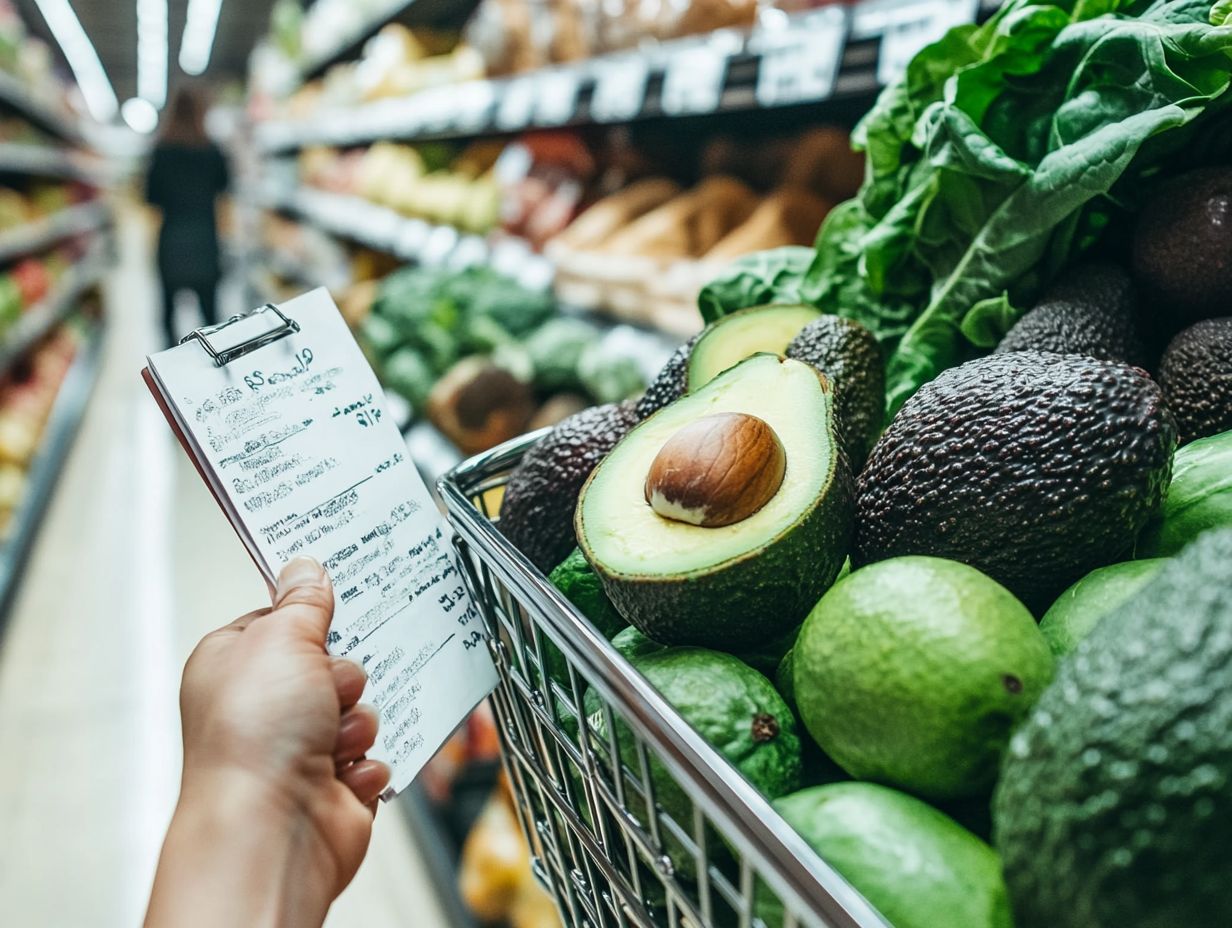
Reading nutrition labels on keto-friendly foods is essential for effectively managing your carb intake and steering clear of hidden sugars and unnecessary additives that could throw your diet off course.
Focus on key elements like net carbs, total carbohydrates, and serving sizes; these will empower you to make informed choices while grocery shopping.
By mastering the art of label reading, you can navigate the grocery store with confidence and find products that align perfectly with your ketogenic meal plan.
It s crucial to understand that net carbs calculated by subtracting fiber and certain sugar alcohols from total carbohydrates are what truly affect your blood sugar levels.
As a keto dieter, keep an eye out for hidden sugars, which may be masquerading under various names such as sucrose, fructose, or high fructose corn syrup.
To simplify the label-reading process, consider carrying a pocket guide to help you decode common terms and sugar substitutes. When comparing similar products, always check the serving size to ensure you re accurately assessing what you’re consuming.
By paying close attention to these details, you can elevate your ketogenic journey and stay dedicated to achieving your health goals.
What are Some Common FAQs About Shopping for Keto?
When you embark on the journey of shopping for keto-friendly foods, it’s natural to encounter a variety of questions and concerns along the way. You may find yourself seeking clarity on how to uphold your dietary goals while maneuvering through the aisles of grocery stores.
Common inquiries often revolve around identifying suitable foods, deciding whether to choose organic options, and mastering the art of meal planning within a keto framework.
By addressing these frequently asked questions, you can equip yourself with the essential knowledge to shop with confidence and purpose, ensuring that your ketogenic lifestyle remains both enjoyable and effective.
Can You Eat Out on the Keto Diet?
You absolutely can enjoy dining out on the Keto Diet by seeking out restaurants that offer low-carb meals and tweaking menu items to meet your dietary needs. Many establishments are increasingly accommodating various dietary preferences, including keto, which means you can savor your dining experiences without derailing your weight loss goals.
By being proactive in selecting keto-friendly options and effectively communicating your preferences to the restaurant staff, you can indulge in delightful meals while staying committed to your ketogenic lifestyle.
When navigating the menu, consider opting for restaurants that prioritize fresh ingredients, like steakhouses or seafood places. You ll often find grilled meats and non-starchy vegetables readily available. Start with appetizers such as shrimp cocktail or a garden salad dressed with olive oil and vinegar to set a satisfying tone for your meal.
Don t shy away from asking for modifications. Substituting rice with cauliflower or requesting sauces on the side can help you manage your carb intake. Focus on protein-rich entr es while avoiding sugary sauces to ensure that each dish aligns perfectly with your keto goals and enhances your dining experience.
Can You Have Cheat Days on the Keto Diet?
While you may wonder about the possibility of cheat days on the Keto Diet, it s crucial to recognize that indulging in high-carb foods can significantly disrupt ketosis and hinder your weight loss journey. Remember, just one cheat day can derail your progress and push you out of ketosis. Stay focused and plan wisely to enjoy treats without guilt!
A cheat day might lead to an increase in carb intake that could take your body several days to recover from, ultimately impacting your overall experience with the diet. If you decide to include cheat days, careful planning is essential, and you must remain mindful of how these indulgences may affect your dietary goals.
If cheat days are on the table, understanding their potential to kick you out of ketosis is vital. Ketosis is the metabolic state where your body burns fat for fuel instead of carbohydrates. A single day of high-carb eating can prompt your body to revert to using carbohydrates for fuel.
Limit cheat days to avoid setbacks or keep them moderate rather than going overboard. Consider planning these indulgent days around your workouts, as exercising afterward can help you bounce back into ketosis more quickly.
Ultimately, embracing moderation and awareness is key to striking the right balance between enjoyment and dietary discipline.
How to Handle Social Events and Gatherings on the Keto Diet?
Social gatherings can be a challenge for keto enthusiasts, but don’t worry! With a little planning, you can enjoy every moment without compromising your goals. Navigating social events while adhering to the Keto Diet can be a bit of a tightrope walk, but with clever meal planning and open communication, you can relish these occasions without straying from your dietary ambitions.
Bring keto-friendly snacks. Also, communicate your dietary preferences to your host. This proactive stance gives you the power to navigate social settings with confidence and ensures you have suitable options at hand, making it much easier to maintain your ketogenic lifestyle.
When you receive an invitation, take a moment to review the menu ahead of time, if possible, so you can spot dishes that align with your keto diet. You might even encourage your friends or family to include keto-friendly options, creating a supportive atmosphere.
For example, consider suggesting a dish that fits your diet. Not only will it please the taste buds, but it will also demonstrate just how delightful keto meals can be. A rich and creamy Greek yogurt parfait with nuts and seeds can be an excellent keto-friendly option.
Keep your focus on socializing and savoring the company around you; after all, your commitment to health doesn t mean you should miss out on the joy of a gathering. Enjoy the experience fully!
How to Stay on Track with Keto While Traveling?
Staying on track with the Keto Diet while traveling demands thoughtful planning and preparation to ensure you have easy access to keto-friendly snacks and meals along the way. Prioritize meal prep before your trip by packing low-carb snacks and researching dining options at your destination that cater to your dietary needs. By being proactive and adaptable during your travels, you can fully enjoy your journey without compromising your commitment to the keto diet!
Consider creating a list of easy-to-pack snacks, such as:
- beef jerky
- cheese crisps
- mixed nuts
These align with your dietary guidelines. Having a go-to meal option in mind simplifies the process of navigating restaurant menus. Look for salads topped with protein and dressings on the side, or grilled meats and vegetables, which are typically available at most eateries.
If you find yourself in a pinch with limited options, don t hesitate to ask for modifications or substitutions. Remember, the key to staying committed while on the road is your ability to plan ahead and remain flexible, enabling you to enjoy new experiences without veering off course from your goals.
Frequently Asked Questions
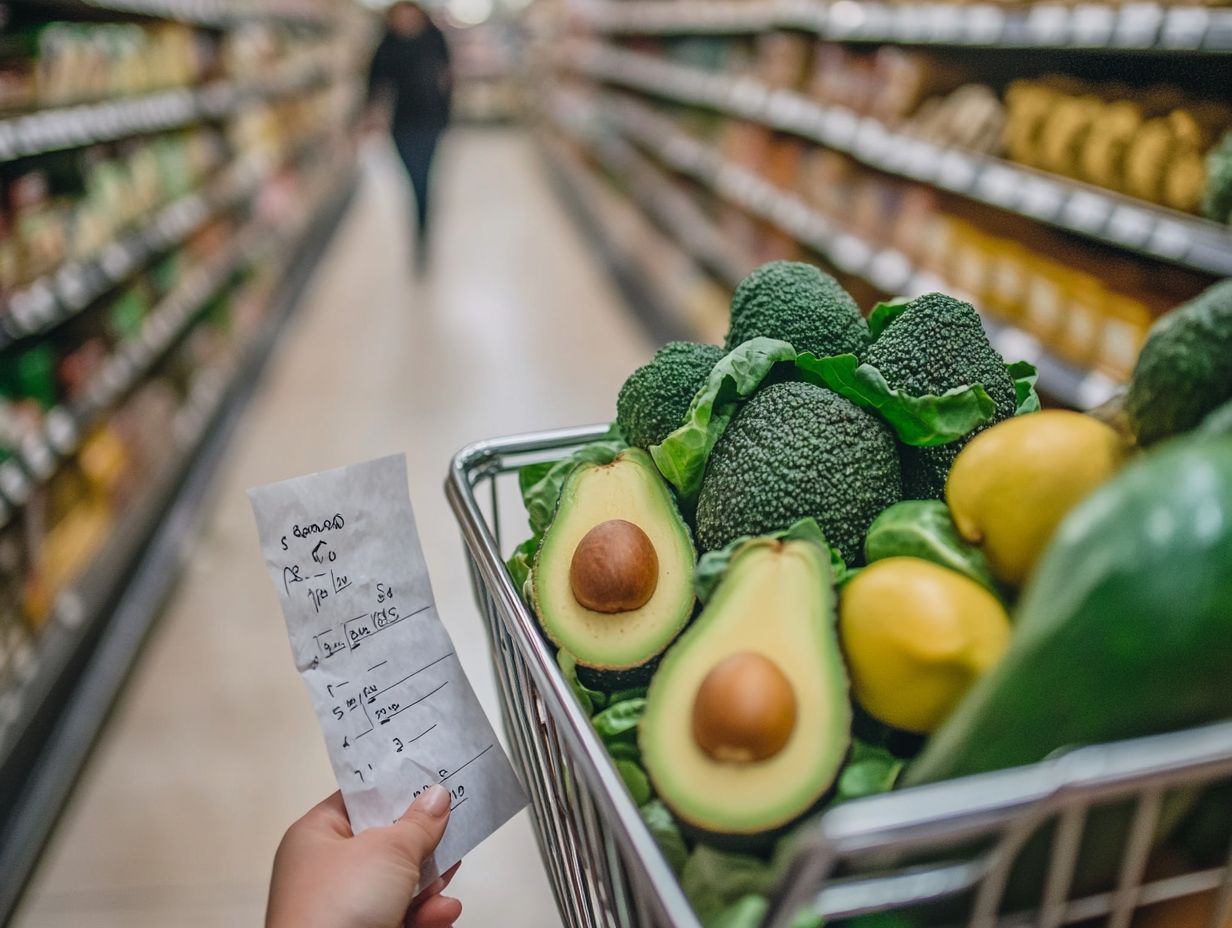
What is the keto diet and how does it affect my shopping habits?
The keto diet is a high-fat, moderate-protein, and low-carbohydrate diet. It aims to put your body in a state of ketosis, where it burns fat for energy instead of carbohydrates. This means that when shopping for keto, you will need to focus on high-fat, low-carb foods.
What foods should I avoid when shopping for keto?
When shopping for keto, you should avoid foods high in carbohydrates, such as grains, starchy vegetables, and sugar. This includes foods like bread, pasta, rice, and most fruits. You should also steer clear of processed and packaged foods, as they often contain hidden carbs.
What are some keto-friendly foods I should include in my shopping list?
Keto-friendly foods include meats, poultry, seafood, and eggs, as well as high-fat dairy products like butter, cream, and cheese. Non-starchy vegetables like leafy greens, avocados, and cauliflower are also great options. Nuts and seeds, such as almonds, walnuts, and chia seeds, are also a good addition to a keto shopping list.
Can I still enjoy sweet treats while on the keto diet?
Yes, there are many keto-friendly sweet treats available, such as sugar-free chocolates and desserts made with low-carb sweeteners like stevia or erythritol. However, these should still be consumed in moderation, as they can still affect your ketosis and weight loss goals.
Do I need to shop at specialty stores for keto-friendly foods?
While there are many specialty stores that offer a wide range of keto-friendly options, you can also find suitable foods at your local grocery store. Just make sure to read labels carefully and prioritize whole, unprocessed foods over packaged and processed options.
How can I save money while shopping for keto?
To save money while shopping for keto, focus on buying whole, unprocessed foods, which tend to be less expensive. You can also look for sales or buy in bulk for non-perishable items like nuts and seeds. Meal planning and preparing meals at home help you save money in the long run.



